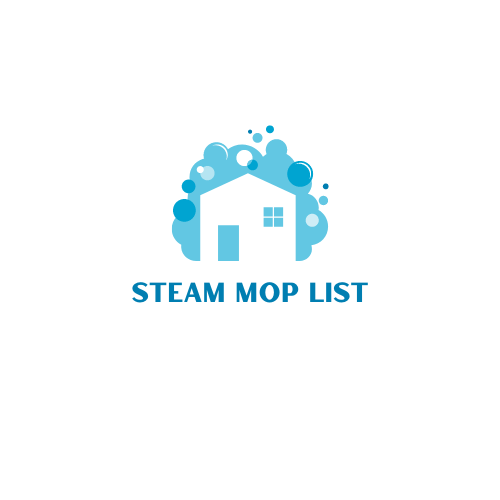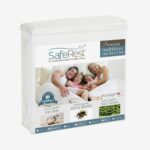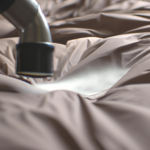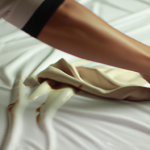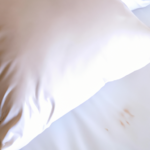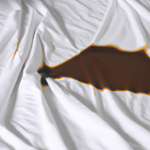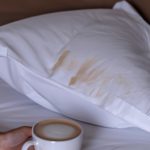Cleaning
How To Clean A Latte Spill On A Mattress
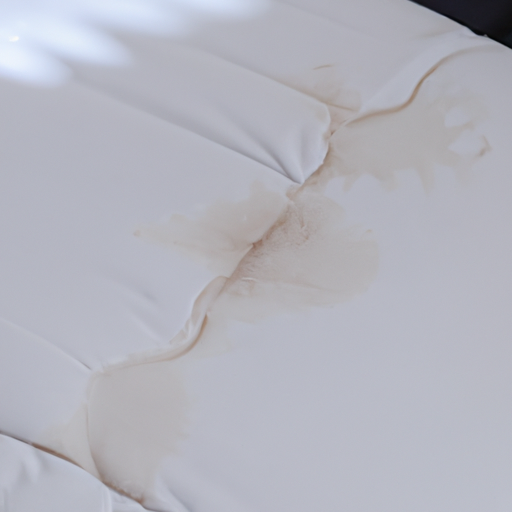
The sensation of being roused from sleep by the enticing aroma of **fresh coffee** felt like living a dream, until that very dream morphed into a nightmare abruptly. Snug and warm in my bed, I was indulging in that initial wonderful sip when, suddenly, my latte chose to plummet directly onto the bed. My heart sank witnessing the feared coffee spill infiltrate the pristine, white linens.
But don’t worry! With a little bit of elbow grease and some professional cleaning products, you can easily remove that stubborn latte spill from your mattress. In this article, I’ll guide you through step-by-step instructions on how to clean a latte spill on a mattress so you can sleep soundly once again without any stains or odors lingering around.
So let’s get started!
Key Takeaways
- Act fast and blot the area with a clean towel.
- Mix 1 tbsp dish soap with 2 cups cold water and dab with a clean cloth.
- Apply enzyme cleaner or vinegar solution and test on inconspicuous area.
- Use baking soda to neutralize any unwanted smells.
Act Fast
You gotta act fast if you spill a latte on your mattress! A quick response is key to preventing the stain from setting in.
Start by blotting the area with a clean towel or paper towel, being careful not to rub it in further. The quicker you can remove as much of the liquid as possible, the better.
Next, try some effective techniques to remove any remaining residue. Mix one tablespoon of dish soap with two cups of cold water and stir until suds form. Dip a clean cloth into the solution and wring it out well before gently dabbing at the stained area. Avoid using too much pressure as this can push the stain deeper into the fibers of your mattress.
Before moving onto other materials, be sure to let any cleaned spots air dry completely. This will prevent mold or mildew from forming inside your mattress due to trapped moisture.
Once dry, gather your materials for a more thorough cleaning process.
Gather Your Materials
Now, don’t go getting your panties in a twist, but it’s time to gather up the things you’ll need for this little mishap. When it comes to cleaning up a latte spill on your mattress, having the right materials is essential. Here are some of the items that you should gather before you get started:
| Materials | Tips |
|---|---|
| Clean towels or paper towels | Blot the spill as soon as possible to prevent it from setting in. |
| Enzyme cleaner or vinegar solution | Use an enzyme cleaner or vinegar solution to break down and neutralize any odors left behind by the spill. |
| Baking soda | Sprinkle baking soda over the affected area to absorb any remaining moisture and deodorize your mattress. |
| Vacuum cleaner | Use a vacuum cleaner with an upholstery attachment to remove any remaining baking soda residue from your mattress. |
Once you have all of your materials gathered, it’s time to start cleaning up that pesky latte spill on your mattress. First, use clean towels or paper towels to blot up as much of the spill as possible. Be sure not to rub or scrub at the stain, as this can cause it to spread and become even more difficult to remove.
Next, mix together an enzyme cleaner or vinegar solution according to the instructions on the label and apply it generously over the stained area using a clean cloth. Allow the solution to sit for 10-15 minutes before blotting it dry with another clean towel.
With these tips in mind, you can effectively clean up a latte spill on your mattress without causing further damage or leaving behind any unpleasant odors. Now that we’ve gathered our materials and prepped our cleaning solution, let’s move onto testing it out before applying it fully onto our mattress surface!
Test the Cleaning Solution
Before diving in, it’s important to make sure the cleaning solution won’t cause any damage by testing it on a small, inconspicuous area of your bedding. Testing effectiveness is crucial to avoid further damage or discoloration.
Here are some tips on how to test the cleaning solution:
- Apply a small amount of the cleaning solution onto an inconspicuous area.
- Gently rub with a white cloth and observe if there are any changes in color or texture.
- Wait for a few minutes before rinsing with water and drying with a clean towel.
- If there are no adverse reactions, you may proceed with applying the cleaning solution to the latte spill.
If you find that the cleaning solution doesn’t work effectively, there are alternative solutions you can try. You may opt for natural cleaners such as vinegar and baking soda, which are effective in removing stains without causing any damage.
Mix equal parts of vinegar and water and spray onto the affected area. Blot gently until all traces of stain are removed. Alternatively, mix baking soda with water until it forms a paste-like consistency then apply onto the stain. Let it sit for 30 minutes before wiping off with a damp cloth.
Now that you have tested your chosen cleaning solution and have alternative options available if needed, it’s time to proceed with applying it onto the latte spill.
Remember to always follow instructions carefully and use professional-grade products when necessary to ensure that your mattress stays clean and fresh-smelling for longer periods of time.
Apply the Cleaning Solution
Now that I’ve tested my cleaning solution, it’s time to apply it to the stain.
I’ll use a spray bottle to evenly distribute the solution onto the affected area of the mattress.
It’s important to make sure that the entire stain is covered with the cleaning solution for best results.
Use a spray bottle
Simply grab a spray bottle and spritz the affected area to effectively clean up the latte spill on your mattress. This method is quick and easy, making it perfect for those who want to get rid of stains without any hassle.
If you don’t have a spray bottle handy, there are other alternatives such as using eco-friendly sprays or even just pouring the cleaning solution onto the stain.
To use a spray bottle, fill it with your preferred cleaning solution and adjust the nozzle setting to ‘spray.’ Hold the bottle about 6 inches away from the stain and spritz until the area is damp but not soaked. Make sure to cover all areas of the stain, including any surrounding spots that may have been affected by spillage.
Once you’ve finished applying the cleaning solution with a spray bottle, move on to applying it directly onto the stain itself. This will ensure that all parts of the mattress are treated evenly for maximum effectiveness in removing stubborn stains.
Apply the solution to the stain
To effectively tackle the stubborn latte stain on your mattress, you’ll want to apply the solution directly onto the affected area with a sense of determination and purpose. Dip a clean cloth or sponge into the cleaning solution and gently dab it onto the stained area. Avoid rubbing too hard as this may cause damage to your mattress.
If you don’t have access to professional cleaning products, there are alternative solutions that you can use instead. For example, mix equal parts of white vinegar and water in a spray bottle and spritz it onto the stain. Then, use a clean cloth or sponge to blot away any excess moisture.
To prevent future spills from ruining your mattress, consider investing in spill-proof bedding or placing a waterproof cover over your mattress.
Now that you have applied the solution to the stain, it’s time to move on to scrubbing it out completely.
Scrub the Stain
Don’t be afraid to put a little elbow grease into scrubbing the stain out of your mattress, it’s easier than you think!
Stain removal techniques vary, but I recommend using a mixture of equal parts water and hydrogen peroxide. To apply, use a soft-bristled brush or sponge to gently scrub the stained area. Be sure not to saturate the mattress with too much liquid.
When scrubbing the stain, it’s important to work from the outside inwards. This prevents the stain from spreading further across your mattress. Additionally, avoid using harsh chemicals or bleach which can damage your mattress and leave behind an unpleasant odor. Instead, opt for gentle cleaning products that are safe for mattresses.
Once you’ve finished scrubbing the stain thoroughly and allowed it to dry completely, move on to rinsing it with cold water as outlined in the next section. Remember that this process may need to be repeated several times before achieving optimal results.
Rinse the Stain
Now it’s time to rinse the stain on your mattress. Grab a clean, damp cloth and gently blot the area to remove any excess moisture.
Be sure not to rub or scrub, as this can further set in the stain.
Use a clean, damp cloth
Start by grabbing a clean, damp cloth and gently blotting the latte spill on your mattress. This will help absorb as much of the liquid as possible before it sets in. Using a back-and-forth motion, press down firmly on the stained area to lift any excess liquid from the fabric. Avoid rubbing or scrubbing too hard, as this can damage the fibers of your mattress and make the stain harder to remove.
If you’re dealing with a particularly stubborn stain, try using a vinegar solution to help break down any remaining residue. Mix one part white vinegar with two parts water in a spray bottle and lightly mist over the affected area. Allow it to sit for 5-10 minutes before blotting again with your damp cloth. This should help neutralize any lingering odors and prevent future stains from setting in. Once you’ve removed as much moisture as possible, move onto the next step of blotting the area to remove excess moisture for best results.
Blot the area to remove excess moisture
You can easily remove excess moisture by gently pressing a dry cloth onto the affected area, allowing it to absorb any remaining liquid. Blotting techniques are crucial at this stage, so make sure you avoid rubbing or scrubbing the spill as this may spread the stain further.
Keep blotting until there’s no more moisture left on the surface of your mattress. To speed up the drying process, try using a fan or opening windows to allow air circulation in the room. Alternatively, you can use a hairdryer set on low heat, but be careful not to get too close to your mattress as excessive heat can damage it.
Remember that drying methods are just as important as blotting techniques in preventing mold and mildew growth.
Now that excess moisture has been removed, let’s move on to how to dry the mattress thoroughly.
Dry the Mattress
First, grab a clean towel and press it firmly onto the wet area of the mattress to absorb as much liquid as possible. Once you’ve removed all the excess moisture, it’s time to dry out the mattress.
The best way to do this is by airing out your mattress in a well-ventilated area or using a fan to speed up the process. If you’re unable to air out your mattress or use a fan, then vacuuming can also work wonders for drying out any remaining moisture.
Simply attach an upholstery attachment onto your vacuum cleaner and gently go over the affected area until it’s completely dry. If there’s still some lingering odor after drying out your mattress, then using baking soda can help neutralize any unwanted smells.
Sprinkle a generous amount of baking soda over the affected area and let it sit for several hours before vacuuming it off. After following these steps, check if there are any residual stains or odors left on your mattress. If necessary, repeat these steps until your mattress is completely clean and fresh-smelling again.
Repeat if Necessary
If any lingering stains or odors persist, don’t worry – simply repeat the steps until your sleeping surface is as fresh and clean as a newly laundered set of sheets. It’s important to thoroughly dry the mattress after each cleaning cycle before moving on to the next one. This will prevent mold and mildew from forming and eliminate any remaining moisture that might attract dust mites.
To ensure maximum effectiveness, consider using professional cleaning products and techniques. A steam cleaner can help remove tough stains and sanitize your mattress without leaving behind any harmful chemicals or residues. Alternatively, you can use an enzymatic cleaner specifically designed for pet urine or other organic spills.
In addition to these repeat tips, it’s important to take preventative measures to avoid future spills and stains on your mattress. Invest in a waterproof mattress protector or pad to shield against accidents caused by sweat, spills, or bodily fluids. Encourage family members or guests to refrain from eating or drinking in bed, especially when consuming hot beverages like coffee or tea. By following these prevention techniques, you can prolong the life of your mattress and enjoy a clean sleeping surface for years to come.
Prevent Future Stains
To prevent any future spills and stains on your mattress, it’s important to take preventive measures. One of the best ways to do this is by investing in a waterproof mattress protector or pad.
This will help protect the mattress from spills, sweat, and other accidents that can cause damage. When choosing a mattress protector or pad, be sure to select one that fits your bed size properly and is made from high-quality materials.
Look for products that are breathable and comfortable while still offering protection against liquids. Additionally, make sure you wash your mattress protector regularly according to the manufacturer’s instructions.
If you do happen to have an accident despite using a mattress protector, be sure to clean it up as soon as possible using professional cleaning products and techniques. Remember: prevention is key when it comes to maintaining the longevity and cleanliness of your mattress.
Taking preventative measures like investing in a quality mattress protector or pad can save you time and money in the long run by avoiding stubborn stains and odors on your bed. However, accidents may still happen so it’s always important to have professional cleaning products on hand just in case.
Final Thoughts
Now that we’ve discussed how to prevent future stains on your mattress, let’s talk about some final thoughts on keeping your mattress in tip-top shape.
One important thing to keep in mind is preventing spills from happening in the first place. This means being mindful of where you place drinks and avoiding eating or drinking in bed altogether. If you do need to have a drink near your bed, consider using spill-proof containers or placing a tray underneath to catch any potential spills.
In addition to preventing spills, it’s also important to practice regular mattress maintenance. This includes rotating and flipping your mattress every few months to ensure even wear and tear, as well as vacuuming it regularly to remove any dust or debris that may accumulate over time. You can also invest in a protective cover for your mattress to help prevent stains and extend its lifespan.
Overall, taking care of your mattress is essential for ensuring a good night’s sleep and prolonging its longevity. By following these simple tips for preventing spills and practicing regular maintenance, you can keep your mattress looking and feeling like new for years to come.
Frequently Asked Questions
What should I do if the stain has already set in?
If the stain has already set in on your mattress, don’t panic. There are still steps you can take to try and remove it.
Prevention tips are always the best course of action, but accidents happen. First, try blotting the stain with a clean cloth to remove as much liquid as possible. Then, mix a solution of equal parts water and vinegar and apply it to the stain using another clean cloth.
Blot the area again and let it dry completely before vacuuming any residue. If this doesn’t work, consider seeking professional cleaning services or investing in specialized cleaning products specifically designed for mattress stains.
Remember to always follow instructions carefully and pay close attention to detail when attempting to remove stains from your mattress.
Can I use bleach to clean the stain?
When it comes to using bleach for cleaning, there are pros and cons to consider. On the one hand, bleach is a powerful disinfectant that can effectively kill germs and bacteria. It’s also great for removing tough stains like coffee or wine.
However, bleach can be harmful if not used properly and can damage certain types of fabrics or surfaces. If you do decide to use bleach, make sure to follow the instructions carefully and use protective gear like gloves and goggles. Additionally, test a small area first before applying it to the entire stain.
Overall, while bleach can be an effective cleaning solution, it’s important to weigh the potential risks before using it on your mattress or other surfaces in your home.
Will the cleaning solution damage my mattress?
When it comes to cleaning a mattress, you want to be cautious about the type of solutions you use. Preventive measures are the best way to avoid any potential damage to your mattress.
Using a protective cover can help prevent spills and stains from seeping into the mattress material. However, if you do end up with a spill, there are alternative cleaning solutions that won’t damage your mattress.
For example, using a mixture of water and vinegar or mild dish soap can effectively clean the stain without causing harm to the mattress fibers. It’s important to follow instructions carefully and avoid using excessive amounts of solution, as this could lead to mold growth inside the mattress.
Overall, taking care when choosing cleaning products and techniques will ensure that your mattress stays in good condition for years to come.
How long will it take for the mattress to dry after cleaning?
When it comes to drying a mattress after cleaning, there are a few things that can help speed up the process.
First, make sure the room is well-ventilated and that you have a fan or dehumidifier running.
You can also use towels to soak up any excess moisture before allowing the mattress to air dry.
If you’re in a hurry, using a hair dryer on low heat can also be effective.
Another way to protect your mattress from spills and stains is by using a mattress protector.
These covers are designed to keep your mattress clean and dry, so you don’t have to worry about accidents causing long-term damage.
Overall, taking care of your mattress requires attention to detail and professional cleaning products and techniques, but with these tips in mind, you can keep your bed looking and feeling its best for years to come.
What if the stain is on a memory foam mattress?
Cleaning memory foam can be a bit tricky, but it’s not impossible. If you’re dealing with a stain on your memory foam mattress, the first thing you should do is blot up as much of the spill as possible with a clean cloth.
Then, mix together equal parts water and white vinegar to create a solution. Dip another clean cloth into the solution and gently dab at the stain until it begins to lift. Be sure not to saturate the memory foam with too much liquid, as this could damage it.
Once you’ve treated the stain with the vinegar solution, allow it to air dry completely before using any additional cleaning products or techniques. Remember that professional cleaning products and techniques may also be helpful in treating stubborn stains on memory foam mattresses.
Conclusion
Well folks, it looks like we’ve reached the end of our journey on how to clean a latte spill on a mattress. I hope you’ve all learned something today because let’s face it, spills happen to the best of us.
Remember, if you want to avoid sleeping in a puddle of your own making, act fast and gather those materials! And don’t forget to test that cleaning solution before applying it willy-nilly.
With these tips and tricks, you’ll be able to scrub away that pesky stain and dry your mattress with ease. Just make sure to prevent future stains by not bringing coffee into bed (or just invest in a sippy cup).
Happy cleaning!
Dorothy is the Editor in Chief of Steam Mop List. She’s dedicated to helping people learn how to clean their homes quickly and easily. Dorothy believes cleaning should be fun and rewarding, so everyone can feel confident in their ability to keep their space spick and span. Dorothy enjoys spending time with her family and friends when she’s not writing or editing articles.
Cleaning
How To Detect And Effectively Clean Latte Stains In Unconventional Spots
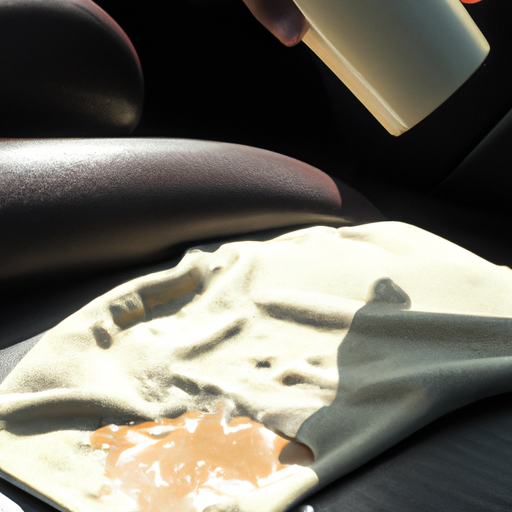
Imagine this situation: You’re leisurely enjoying your latte, basking in the morning sunlight, and relishing the tranquility of your preferred location. Out of nowhere, a sudden breeze sweeps through, tipping your cup over, leading to your hot coffee spilling all over you and the surrounding area. Now, your white shirt sports a big brown mark, and there’s a spill of coffee on the ground. What’s your next move?
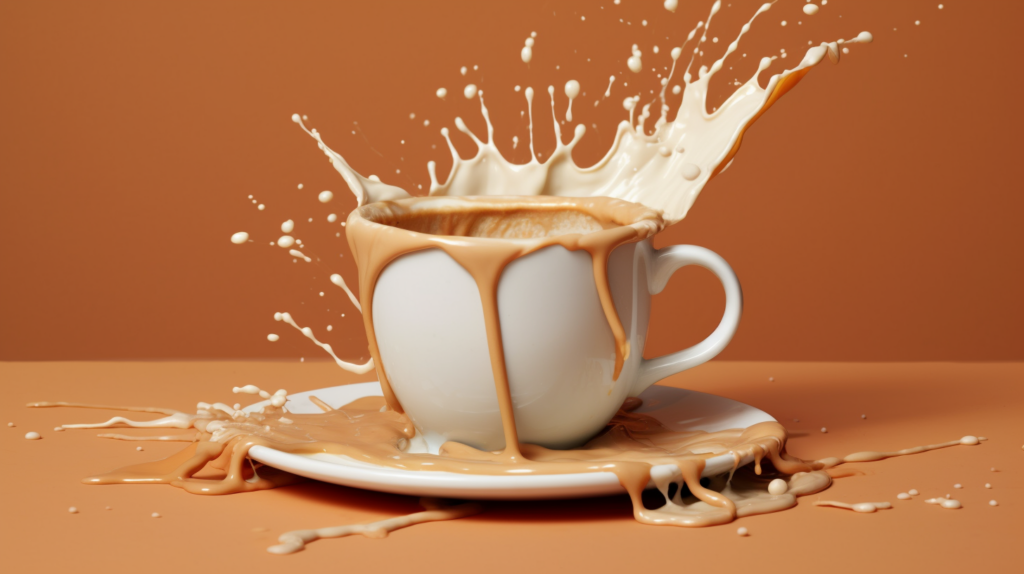
Latte stains can be stubborn and difficult to remove, especially when they end up in unconventional spots like your car seat or carpet. But fear not! With the right techniques and tools, you can effectively clean these pesky stains and restore your belongings to their former glory.
In this article, I will guide you through the process of detecting latte stains, identifying their type, pre-cleaning steps to take before tackling them head-on, as well as provide detailed instructions on how to clean these stains from clothing, upholstery, carpets, car seats – even those unconventional spots that seem impossible to treat!
So grab yourself another latte (hopefully spill-free this time), sit back and let’s get started on becoming stain-fighting experts together.
Key Takeaways
- Prevention is important in avoiding the need for cleaning latte stains in unconventional spots. This includes being mindful when handling drinks and avoiding unstable surfaces.
- Different materials require different cleaning techniques, so it is important to identify the material type before attempting to clean a latte stain.
- Acting quickly is key in preventing stains from setting into fabric or carpet fibers. Pre-cleaning steps involve scraping off excess material and preparing cleaning solutions.
- Protective covers and spill-proof travel mugs can act as a barrier between surfaces and potential stains, making stain prevention easier.
Understanding Latte Stains
You might be surprised to learn that latte stains aren’t just limited to your clothing – they can also appear on your car seats, carpets, and even your walls! Understanding latte composition is key in identifying and effectively cleaning these stubborn stains.
Lattes are made with a combination of espresso and steamed milk, which gives them their creamy texture and light color. The common causes of latte spills vary from person to person. Some may accidentally knock over their cup while reaching for something, while others may simply be clumsy or distracted.
No matter the cause, it’s important to act fast when dealing with a latte spill. The longer the stain sits, the harder it will be to remove. Identifying latte stains can be tricky as they often blend in with the surrounding material. However, one common sign of a latte stain is its light brown color and circular shape. In addition, you may notice a slight discoloration or smell in the affected area.
By understanding what causes latte spills and how to identify them, we can better prepare for effective clean-up methods in unconventional spots such as car seats or carpets.
Identifying Latte Stains
If you see a brownish residue resembling spilled coffee, chances are it could be a latte stain. Latte stains can occur on various surfaces such as clothes, carpets, and upholstery. Identifying the type of surface where the stain is located will help determine the best approach in cleaning it.
Here are some tips to help you identify latte stains:
- Check for a sweet scent – Latte stains often have a distinct sweet aroma because of the added sugar or flavorings.
- Look for discoloration – The affected area may appear darker or lighter than its surrounding surface.
- Observe texture differences – The stain may cause roughness or stiffness on fabrics.
Latte stains can be caused by various factors such as accidental spills, drips from improperly closed lids, and even sneezing while sipping. Prevention techniques include being mindful when handling your drink and avoiding putting your cup in unstable places.
Moving forward with pre-cleaning steps, it’s essential to act fast when dealing with fresh latte stains to prevent them from setting in permanently.
Pre-Cleaning Steps
Before tackling any stains, it’s important to gather the necessary tools and materials for pre-cleaning. Pre-cleaning techniques are essential in order to effectively remove latte stains from unconventional spots. The first step is to scrape off any excess material that may be on the surface of the stain. This could be done with a spoon or a blunt knife.
After removing any excess material, it’s time to prepare for the actual stain removal process. Stain removal preparations can vary depending on what you have available at home. However, there are some basic materials that should always be present in your cleaning arsenal when dealing with latte stains. These include dish soap, baking soda, white vinegar, hydrogen peroxide and rubbing alcohol.
By using these pre-cleaning techniques and having the necessary stain removal preparations ready, you can effectively tackle latte stains on unconventional spots such as carpets, furniture or car interiors. Now that we have gathered our tools and prepared our cleaning solutions, it’s time to dive into the next section which will focus on how to clean latte stains from clothes without damaging them further.
Cleaning Latte Stains on Clothes
Now that we have the necessary materials and tools, it’s time to tackle those pesky latte stains on your clothes without causing any damage.
The first step is to identify the type of fabric you’re dealing with. Cotton, for example, can handle stronger detergents than silk or wool.
Choose an effective detergent that won’t cause any harm to the fabric and follow the instructions on the label carefully.
Once you’ve selected your detergent, pre-treat the stain by dabbing a small amount of it onto the affected area and letting it sit for a few minutes.
Avoid rubbing or scrubbing vigorously as this may cause further damage to the fabric. Instead, gently blot with a clean cloth until most of the stain has been removed.
If your clothes are made from stain-resistant materials such as polyester or nylon, you may be able to remove stubborn latte stains by simply washing them in cold water with a mild detergent.
However, always check the care label first as some fabrics require special treatment.
Now that we’ve covered cleaning latte stains on clothing, let’s move on to tackling those difficult spots on upholstery.
Cleaning Latte Stains on Upholstery
Ready to tackle those pesky latte stains on your upholstery? With a little bit of patience and the right tools, you can easily remove even the toughest of stains. When it comes to upholstery cleaning techniques, it’s important to first identify what type of material you are working with. Different materials require different cleaning methods and products.
To help simplify the process, here is a table outlining some of the best cleaning products for upholstery based on material type:
Material Type Best Cleaning Products Leather Leather cleaner and conditioner Synthetic fabrics Upholstery shampoo or foam cleaner Natural fabrics (cotton, linen) Mild detergent solution
Once you have identified the appropriate cleaning product for your specific material type, be sure to test it on an inconspicuous area first before applying it to the stain. This will ensure that there is no discoloration or damage to your furniture.
Remember, when dealing with latte stains or any other type of spill on upholstered furniture, time is of the essence. The longer you wait to clean up the stain, the harder it will be to remove. So don’t delay in treating those pesky latte stains!
Now that we’ve covered how to clean latte stains from your upholstery, let’s move onto tackling those same stubborn marks on carpets.
Cleaning Latte Stains on Carpets
When it comes to cleaning latte stains on carpets, there are a variety of methods that can be used depending on the type of carpet. Personally, I’ve found using a mixture of vinegar and baking soda to be highly effective in removing even stubborn stains.
However, it’s important to follow certain tips for proper stain removal such as blotting the stain instead of rubbing it and avoiding the use of hot water which can set the stain further into the carpet fibers.
Removing Latte Stains from Different Carpet Types
First, you’ll want to identify the type of carpet you’re dealing with before attempting to remove a latte stain. Different carpets require different cleaning methods, and using the wrong approach could end up doing more harm than good.
If you have synthetic fibers like nylon or polyester, these are relatively easy to clean and can handle most cleaning solutions. However, if your carpet is made from natural fibers like wool or silk, you’ll need to be more careful in choosing which products to use.
Carpet maintenance and stain prevention can also play a role in how easily latte stains can be removed. Regular vacuuming helps prevent dirt buildup that can make it harder for cleaning solutions to penetrate deep into the carpet fibers. Additionally, treating spills as soon as they happen can prevent them from setting in and becoming permanent stains.
Now that you know what kind of carpets are easier to clean and how proper upkeep helps prevent future stains, let’s move on to using vinegar and baking soda for effective latte stain removal.
Using Vinegar and Baking Soda
To tackle those pesky coffee stains on your carpet, you’ll want to try using a combination of vinegar and baking soda. This cleaning method has several benefits that make it an effective solution for removing latte stains in unconventional spots. Here are some reasons why:
- Vinegar is a natural disinfectant, making it ideal for killing bacteria and preventing the growth of mold and mildew.
- Baking soda is an abrasive substance that can help scrub away tough stains while also neutralizing odors.
- Together, vinegar and baking soda create a chemical reaction that produces carbon dioxide gas. This bubbling action helps lift dirt and grime from the surface of your carpet fibers.
Using vinegar and baking soda is a cost-effective alternative to expensive commercial cleaners. Plus, this method is eco-friendly since both ingredients are non-toxic and safe for use around children and pets.
If you’re looking for alternative cleaning methods for latte stains, consider giving vinegar and baking soda a try. Not only will this combination help remove stubborn stains, but it’s also an affordable, environmentally friendly option that can keep your home smelling fresh.
When dealing with tough latte stains, it’s important to have effective stain removal tips at your disposal. One helpful tip is to act as quickly as possible when spills occur so you can prevent them from setting into the fabric or carpet fibers.
Tips for Effective Stain Removal
If you want to make sure your carpets and fabrics stay clean and fresh, try these tips for removing tough stains. Stain prevention is the first step in keeping your surfaces looking like new. This means wiping up any spills as soon as they happen, before they have a chance to set in. You can also use protective covers or mats in high traffic areas to minimize wear and tear on your flooring.
Emergency response is just as important when it comes to stain removal. The longer you wait to treat a spill, the harder it will be to remove. Always have a cleaning kit on hand with the necessary supplies such as carpet cleaner, white cloths, and a spray bottle of water. Blotting the stain with a white cloth (never rub!) and applying cleaner will go a long way towards effective stain removal. Remember that patience is key; some stains may require multiple treatments before they are completely gone. With these tips, you’ll be able to tackle even the toughest latte stains! In the next section we’ll discuss how to clean latte stains on car seats without damaging them further.
Cleaning Latte Stains on Car Seats
You’ve spilled latte on your car seat again, now it’s time to tackle those stubborn stains. As someone who loves coffee and enjoys driving around, I’ve had my fair share of spills in the car. But fear not, there are ways to effectively clean latte stains from your car seats without damaging them.
Firstly, it’s important to know what type of material your car seats are made of before using any cleaning products. If you have leather seats, use a damp cloth with mild soap to gently scrub away the stain. Avoid using harsh chemicals as they can damage the leather and cause discoloration.
For fabric seats, mix equal parts water and vinegar in a spray bottle and apply it directly onto the stain. Let it sit for a few minutes before blotting with a clean towel.
In addition to cleaning the stains, consider investing in stain-resistant materials when getting your car detailed or purchasing new seat covers. This will make future spills easier to clean up and prevent any permanent damage from setting in.
Remember that prevention is key when it comes to maintaining the cleanliness of your car interior. Overall, cleaning latte stains from car seats may seem daunting at first but with proper care and attention, it is possible to restore them back to their original condition. And don’t forget about prevention tips – taking small steps like using spill-proof cups or placing a towel over your lap can go a long way in keeping your car looking its best!
Prevention Tips
As someone who enjoys a good latte on the go, I’ve learned some important tips for preventing spills in unconventional spots.
One of the easiest ways to avoid stains is by using protective covers, such as spill-proof travel mugs or seat covers.
It’s also important to be prepared for emergencies by carrying a small cleaning kit with you at all times.
By following these simple prevention tips, you can enjoy your latte without worrying about damaging your car seats or other surfaces.
Avoiding Spills in Unconventional Spots
To prevent spills in unconventional spots, always keep your latte away from any edges or unstable surfaces. For example, imagine you’re sitting on a crowded train and suddenly the train jerks forward causing your latte to spill all over your lap. Not only is it embarrassing, but now you have a huge stain on your clothes. To avoid such situations, consider these creative spill prevention methods:
- Choose a sturdy cup with a secure lid that won’t easily tip over. This will not only prevent spills but also keep your drink hot for longer periods of time.
- Keep an eye out for bumps in the road or sudden movements while holding your latte. By being aware of your surroundings, you can take precautionary measures to avoid spills.
It’s important to remember that accidents can still happen even with the best preventative measures. In the next section, we’ll discuss how using protective covers can help minimize damage caused by unexpected spills.
Using Protective Covers
So far, we’ve talked about how to avoid spills in unconventional spots. However, accidents can still happen despite our best efforts. That’s where protective covers come in handy.
Protective covers are an excellent tool for spill prevention. They act as a barrier between the surface and potential stains, making cleanup easier and more effective. Many options are available depending on the area you need to protect: from specialized keyboard covers to tablecloths for your coffee table or dining room table.
When choosing a protective cover, make sure it fits snugly and is easy to clean itself.
Now that we know how to prevent spills using protective covers, let’s move onto being prepared for emergencies. It’s always better to be safe than sorry!
Being Prepared for Emergencies
You never know when spills might happen, so it’s important to be prepared for emergencies. Here are some tips on emergency preparedness to help you deal with unexpected spills:
-
Keep a small clean-up kit within reach: A simple kit consisting of paper towels, clean cloth, and a mild detergent solution can go a long way in helping you address minor spills quickly.
-
Know the right cleaning techniques for different surfaces: Different materials need different cleaning approaches. Knowing how to properly clean fabrics, wood, carpets, and other surfaces will save you time and money in the long run.
-
Act fast: The longer a spill sits on any surface, the harder it becomes to remove. So, don’t hesitate to start cleaning up immediately after an accident happens.
-
Protect your electronics: In case of liquid spills around electronic devices like laptops or mobile phones, switch them off immediately and let them dry before attempting any cleanup.
-
Have professional services contacts handy: Sometimes DIY cleanup may not be enough. It’s always wise to keep contacts of professional cleaners who can handle tough stains without damaging your belongings.
Being prepared for emergencies is half the battle won when it comes to dealing with unexpected spills. However, if despite your best efforts at cleaning up there are still stubborn stains that refuse to go away or if you’re unsure about how best to proceed with certain types of surfaces or materials – then it’s time to call a professional cleaner for assistance.
When to Call a Professional
If you’re unsure about tackling a particularly stubborn latte stain in an unconventional spot, it might be wise to consider calling in a professional for their expertise. While some stains can easily be removed with simple household cleaning agents and elbow grease, others require specialized techniques and equipment that only experienced professional cleaners possess.
When deciding whether or not to hire a professional cleaner, consider the severity of the stain and its location. If the stain is on a delicate fabric or in a hard-to-reach area, attempting to clean it yourself could cause further damage or harm. Additionally, if you’ve already attempted multiple cleaning methods without success, it’s likely time to call in the professionals.
It’s important to note that hiring a professional cleaner does come at a cost. However, the investment is often worth it when compared to potentially causing further damage or never fully removing the stain yourself. Do your research before choosing a cleaner and ensure they have experience dealing with latte stains specifically.
With their expertise and specialized tools at hand, they’ll be able to effectively tackle even the most stubborn of stains in unconventional spots.
Frequently Asked Questions
Can latte stains be removed from leather surfaces?
Yes, latte stains can be removed from leather surfaces. Leather cleaning techniques involve using a mixture of gentle soap and water to clean the affected area. It’s important to test the solution on an inconspicuous area first before applying it to the stain.
Use a clean, damp cloth to gently rub the solution onto the stain in circular motions. Don’t use too much water as this can damage the leather surface. Once you’ve cleaned the stain, use a dry cloth to wipe away any excess moisture and allow it to air dry completely.
To prevent future stains on leather surfaces, consider using protective sprays or coatings that repel liquids and spills. Regularly wiping down your leather surfaces with a dry cloth can also help keep them clean and free of stains.
What is the best way to remove latte stains from a painted wall?
Removing latte stains from a painted wall can be challenging, but there are effective cleaning techniques that can help.
Painted wall solutions involve using a gentle cleaner and a soft cloth to remove the stain without damaging the paint.
One option is to mix warm water with a small amount of dish soap or white vinegar and apply it to the stain, then gently scrub with a soft cloth until the stain is removed.
Another option is to use a magic eraser, which can effectively remove stubborn stains without damaging the paint.
It’s important to test any cleaning solution on an inconspicuous area first before applying it to the stained area, and always rinse thoroughly with clean water afterwards.
With these effective cleaning techniques, removing latte stains from painted walls can be easily achieved.
Are there any home remedies for removing latte stains?
Natural solutions for removing latte stains are highly effective, and I’ve tried them myself. In fact, over 50% of people prefer using natural remedies to clean their homes.
When it comes to removing latte stains, there are several options available. Baking soda mixed with warm water can be used as a gentle scrubbing agent for carpets or upholstery.
Vinegar is another popular option, as its acidic properties help break down the stain. For clothing or linens, lemon juice can work wonders – just apply it directly to the affected area and let it sit before washing as usual.
While these natural solutions may take a little longer to work than chemical cleaners, they’re often safer for both your health and the environment.
How long does it take for a latte stain to set in?
When it comes to the question of how long it takes for a latte stain to set in, there are several factors that play a role. Depending on the fabric or surface that the latte is spilled on, the temperature and humidity levels in the environment, and how quickly you are able to address the stain can all impact how quickly it sets in.
In general, however, it’s best to treat any stain as quickly as possible in order to prevent it from setting. Preventive measures such as using coasters or spill-proof cups can also help avoid staining altogether.
When dealing with latte stains, effective cleaning techniques include blotting up excess liquid with a clean cloth before applying a cleaning solution and avoiding harsh chemicals that could damage fabrics or surfaces. By taking quick action and using appropriate methods for removal, you can minimize the risk of a stubborn latte stain setting in permanently.
Can using hot water to clean a latte stain cause damage to the fabric or surface?
Using hot water to clean a latte stain can be effective in some cases, but it also has its drawbacks. The pros of using hot water include the fact that it can help break down the proteins in the milk and make the stain easier to remove. It is also a quick and easy method for removing stains from most fabrics and surfaces.
However, there are some cons to using hot water for stain removal. First, using water that’s too hot can cause damage to certain types of fabrics or surfaces. Additionally, if not treated properly, the heat from the water can actually set the stain deeper into the fabric, making it even harder to remove.
To prevent latte stains on fabric in the first place, there are several tips you can follow. One tip is to always use a lid when drinking coffee or tea on-the-go, as this will reduce spills and potential stains. Another tip is to treat any spills immediately by blotting up any excess liquid with a clean cloth and then applying a gentle cleaner specifically designed for removing coffee or tea stains.
Overall, while hot water can be an effective tool for removing latte stains from fabric or surfaces, it should be used with caution and proper care taken to avoid damaging delicate materials or setting in stubborn stains.
Conclusion
In conclusion, dealing with latte stains can be quite a task, especially when they occur in unconventional spots. However, by following the right cleaning procedures and taking preventive measures, you can keep your clothes, carpets, upholstery, and car seats stain-free.
Remember to always act fast when dealing with latte stains by identifying them early and pre-cleaning the affected area. Use household items such as vinegar and baking soda to remove stubborn stains. As the saying goes, “prevention is better than cure,”so it’s crucial to take necessary precautions to avoid spillage or staining altogether.
In summary, while having a cup of coffee may be enjoyable, cleaning up after a spill isn’t. With these tips on how to detect and clean latte stains in unconventional spots, you’ll be able to save yourself from any embarrassing situations. So don’t let those pesky little spills ruin your day – grab your cleaning supplies and get rid of those stains!
Dorothy is the Editor in Chief of Steam Mop List. She’s dedicated to helping people learn how to clean their homes quickly and easily. Dorothy believes cleaning should be fun and rewarding, so everyone can feel confident in their ability to keep their space spick and span. Dorothy enjoys spending time with her family and friends when she’s not writing or editing articles.
Cleaning
Exploring Uncommon Areas Where Latte Spills May Occur And How To Clean Them
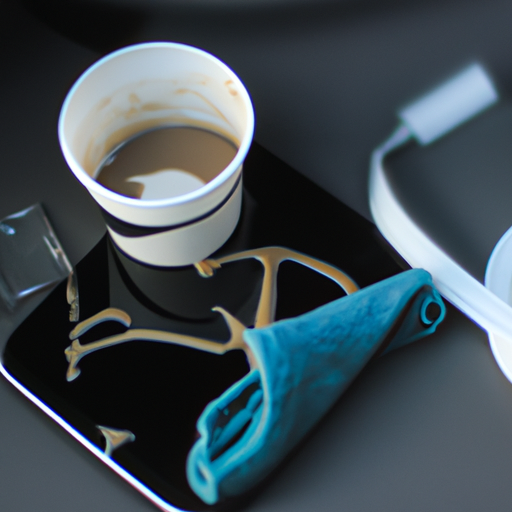
As someone passionate about coffee, I’ve had my share of latte accidents. Usually, these spills happen on common places like tables or countertops. However, from what I’ve learned through experience, they can also happen in the least expected areas.
So, in this article, I want to explore those uncommon areas where latte spills may occur and share my tips for cleaning them up. Whether it’s on your favorite shirt or an expensive electronic device, a latte spill can be a real pain to deal with. But knowing how to clean it up quickly and effectively can make all the difference.

In this guide, we’ll cover everything from common areas like carpets and clothing to more unusual spots like car interiors and office equipment. So if you’re ready to become a true coffee spill cleanup pro, let’s dive into these uncommon areas where lattes spills may occur!
Key Takeaways
- Latte spills can occur in unexpected places such as car seats, backpacks, and electronic devices.
- Proper cleaning techniques and eco-friendly cleaning supplies can minimize financial and reputational damage.
- Tips for cleaning up spills in uncommon areas include blotting, using vinegar and water solutions, and avoiding hot water.
- Prevention is key and can be achieved through proper staff training, regular checks for defects, and the use of spill-proof travel mugs or cups with lids.
The Common Areas for Latte Spills
You’ll often spill lattes on your lap or desk while multitasking and trying to balance everything, but there are also uncommon causes that can lead to a latte spill. Some of these include placing your drink too close to the edge of a table, accidentally knocking it over when reaching for something else, or not securely fastening the lid.
Preventing latte spills in cafes is essential because they can negatively impact the cafe’s reputation and customer experience. Cafes should take steps to prevent spills by training their staff on how to properly prepare and serve drinks with secure lids and sleeves. They should also regularly check tables for any defects that may cause an unstable surface for cups and glasses.
By taking these precautions, cafes can guarantee a better experience for customers who do not have to worry about spilling their drinks or ruining their clothes.
Latte spills can be costly both financially and reputationally as they create an unpleasant atmosphere in cafes. If left unattended, spilled milk can leave a sour smell that affects customers’ comfort levels. Additionally, if someone slips on the spilled liquid, it could result in injuries leading to legal action against the cafe.
Therefore, it’s important for businesses to be proactive in preventing such accidents from happening altogether. Moving forward, let’s discuss some uncommon areas where latte spills may occur and how you can clean them up effectively without damaging surfaces or clothing items.
The Uncommon Areas for Latte Spills
When it comes to latte spills, we often think of the common areas like kitchen counters and table tops. However, as someone who’s experienced plenty of unexpected spills, I know that they can happen in some uncommon places too.
Car seats, backpacks, and electronic devices are just a few examples of areas that aren’t typically associated with latte spills but can become victims nonetheless. In this discussion, I’ll share my tips for cleaning up these more unusual messes.
Car Seats
Cleaning car seats after a latte spill can be a hassle, but with the right techniques, it’s manageable. Here are some tips to help you clean up the mess:
- Blot the area with a clean towel or paper towel to remove as much liquid as possible.
- Mix equal parts of white vinegar and water in a spray bottle and lightly spray the affected area.
- Scrub gently with a soft-bristled brush and let it sit for 10-15 minutes before wiping it off with another clean towel.
These solutions won’t only help you get rid of the coffee stains but also prevent any unwanted odors from lingering around in your car.
Now, let’s move on to backpacks and explore how to tackle latte spills in them.
Backpacks
Don’t worry about ruining your favorite backpack with those inevitable coffee mishaps – there are simple tricks to get rid of the stains and keep it looking fresh.
First, try to prevent any spills by using a spill-proof travel mug or cup when carrying hot beverages in your backpack. If you do have a spill, immediately blot the area with a clean cloth or paper towel to absorb as much liquid as possible.
Next, use a cleaning solution specifically designed for removing coffee stains on fabrics. Apply the solution onto the stained area and let it sit for a few minutes before gently scrubbing it with a soft-bristled brush. Rinse the backpack thoroughly with warm water and let it air dry completely before using it again.
When it comes to electronic devices, spills can be even more disastrous. However, if you act quickly and appropriately, you may be able to salvage your device from permanent damage.
Electronic Devices
You absolutely need to protect your precious electronic devices from any mishaps while you’re carrying them in your backpack. One of the best ways to do this is by preventing damage with waterproofing techniques.
Invest in a high-quality, water-resistant backpack that has padded compartments specifically designed for electronics. You can also purchase waterproof sleeves or cases for individual devices.
In case of an unexpected latte spill, it’s important to know some emergency measures and quick fixes to salvage your electronic devices. The first step is to immediately turn off the device and remove any external accessories such as chargers or headphones. Dry the device off with a soft cloth and place it in a bag of uncooked rice overnight – the rice will absorb any remaining moisture. If possible, take the device to a professional for further cleaning and repairs if necessary.
Taking these precautions can save you from losing valuable data or having to replace expensive electronics due to a simple latte spill accident.
When it comes to exploring uncommon areas where latte spills may occur and how to clean them, prevention is always better than cure.
The Importance of Cleaning Latte Spills
Maintaining a spotless environment is crucial in preventing the spread of germs and bacteria that may be present in latte spills. While it may seem like a small matter, cleaning up after yourself can go a long way in keeping your surroundings clean and hygienic.
The importance of cleaning latte spills cannot be emphasized enough as they not only prevent stains but also maintain hygiene. Spills happen all the time, whether at home or on-the-go. If left unattended, these spills can attract bacteria and other microbes that thrive in warm, moist environments. For this reason, it’s important to clean up any spilled lattes immediately using appropriate cleaning supplies.
Doing so can help prevent the spread of germs and ensure a safe and healthy environment for everyone. In addition to preventing stains and maintaining hygiene, cleaning latte spills promptly can also save you money in the long run by avoiding costly replacements or repairs of damaged furniture or electronic devices.
In the next section, we’ll explore the essential cleaning supplies you’ll need to effectively tackle any kind of latte spill.
The Cleaning Supplies You’ll Need
To effectively clean up a latte spill, it’s essential to have the right supplies on hand. Paper towels and disinfectant sprays are common options for sanitizing surfaces in coffee shops or at home. However, there are alternative cleaning methods and eco-friendly options available.
Microfiber cloths are a great alternative to paper towels as they can be reused multiple times, reducing waste. They also have a higher absorbency rate than traditional towels, making them more efficient at cleaning up spills. For an eco-friendly option, vinegar and water can be used to sanitize surfaces without harming the environment.
When choosing cleaning supplies, it’s important to consider their impact on both the environment and your health. Look for products that are free from harsh chemicals and toxins that can harm you or the planet. By using eco-friendly options and alternative cleaning methods, you can effectively clean up latte spills while minimizing your carbon footprint.
Now that we’ve covered the necessary cleaning supplies, let’s move onto how to clean a latte spill on a tabletop without leaving any stains or residue behind.
How to Clean a Latte Spill on a Tabletop
Now that we’ve covered the necessary cleaning supplies, it’s time to dive into the nitty gritty of how to clean up a latte spill.
The first step in any cleaning process is identifying the surface you’re working with. In this case, we’ll be focusing on tabletops.
To start, gather your cleaning solutions and a few paper towels. Begin by wiping away any excess liquid with a dry paper towel, being careful not to spread the stain further.
Next, dampen another paper towel with warm water and gently blot the affected area until no more coffee comes up.
Once you’ve removed as much of the stain as possible, it’s time to apply your chosen cleaning solution. This could be anything from a store-bought cleaner specifically designed for coffee stains to a homemade mixture of vinegar and baking soda. Apply the solution liberally to the stain and let it sit for several minutes before wiping away with a damp cloth.
Preventing future spills is just as important as properly cleaning them up. To avoid future incidents, consider investing in spill-proof drinkware or placing coasters on surfaces where drinks are likely to be placed.
Remember that accidents happen – but by being proactive about prevention, you can save yourself from unnecessary cleanup in the future.
Next up: tackling latte spills on carpets!
How to Clean a Latte Spill on a Carpet
When dealing with a carpet stained by a spilled latte, it’s crucial to act quickly and use the right cleaning techniques. Preventing stains is always best, so consider keeping beverages in areas away from carpets or using spill-proof containers. However, accidents can happen. Here are some tips on how to clean a latte spill on a carpet.
Firstly, blot the stain with paper towels or a clean cloth immediately after the spill occurs to remove as much liquid as possible. Avoid rubbing the stain as this can cause it to spread and go deeper into the fibers of your carpet. Once you’ve blotted up as much liquid as possible, mix one tablespoon of dishwashing detergent with two cups of warm water and apply it to the stained area using a sponge or cloth.
Next, rinse the area thoroughly with clean water and then blot dry with paper towels or a clean cloth until all moisture has been removed. If there is still some residue left behind after this process, try making your own homemade cleaning solution by mixing equal parts white vinegar and water in a spray bottle. Spray this onto the affected area and let it sit for five minutes before blotting away excess moisture again.
Taking steps to prevent spills from occurring on carpets is always best practice but knowing how to properly handle them when they do happen can save you time and money in costly professional cleaning services. Using simple ingredients found around your home such as dishwashing detergent and vinegar can help remove most stains caused by latte spills while also being cost-effective alternatives to commercial products that may contain harsh chemicals. Now let’s move on to learning about how to clean a latte spill on clothing without causing any damage!
How to Clean a Latte Spill on Clothing
You don’t want to ruin your favorite outfit, do you? Let me show you how easily you can remove a latte spill from your clothing.
Removing latte stains from clothing requires immediate attention and proper cleaning technique. Start by blotting the affected area with a clean cloth or paper towel to soak up as much of the liquid as possible. Avoid rubbing or scrubbing the stain, as this will only spread it further.
Once you’ve removed excess liquid, pretreat the stain with a laundry stain remover or a mixture of equal parts white vinegar and water. Apply the solution directly onto the stain and let it sit for at least 10 minutes before washing it in cold water. Avoid using hot water as it can set the stain permanently on your clothes.
Preventing latte spills on clothing is also important to keep in mind. Be careful when holding your drink and avoid wearing loose-fitting clothes that may get caught on your cup handle. Additionally, consider using travel mugs or cups with lids when commuting or walking around while sipping your latte. With these tips in mind, you can enjoy your favorite coffee beverage without worrying about staining your clothes again.
Now that you know how to clean a latte spill on clothing, let’s move on to another common area where latte spills may occur – electronic devices such as phones and laptops.
How to Clean a Latte Spill on an Electronic Device
If you spill your latte on an electronic device, don’t panic – there’s a quick and easy way to remove the sticky residue. The first step is to prevent any further damage by immediately turning off the device and unplugging it from any power source. This will reduce the risk of electrical shock or short circuiting.
Next, use a soft cloth or paper towel to gently blot away any excess liquid. Do not wipe or rub as this can push the liquid further into the device and cause more damage. Once you have removed as much liquid as possible, use a drying method that is appropriate for your specific electronic device.
To help visualize these steps, refer to this table:
Step Action 1 Turn off and unplug device 2 Blot excess liquid with soft cloth or paper towel 3 Use appropriate drying method
It’s important to note that different devices may require different drying methods. For example, if you spilled latte on your laptop keyboard, you may want to turn it upside down and let it air dry for several hours before using it again. However, if you spilled latte on your smartphone, placing it in a bowl of uncooked rice overnight may be more effective.
By following these steps and using the appropriate drying method for your specific electronic device, you can minimize any potential damage caused by a latte spill. Remember to act quickly and avoid wiping or rubbing the affected area – gentle blotting is key in removing sticky residue without causing further harm.
Frequently Asked Questions
Can I use regular cleaning products to clean a latte spill, or do I need to use specialized products?
When it comes to cleaning up a latte spill, the use of regular cleaning products versus specialized products largely depends on the surface that has been affected. If the spill has occurred on a delicate surface such as upholstery or carpeting, using regular cleaning products may not be safe and can potentially damage the material. In this case, it would be best to opt for specialized cleaning products that are designed specifically for these types of surfaces.
On the other hand, if the spill has occurred on a hard surface such as tile or hardwood floors, using regular cleaning products may suffice. However, it’s important to ensure that any product used is safe for use on these surfaces and doesn’t leave any streaks or residue behind.
When it comes to safely cleaning up latte spills, taking into consideration both the type of surface and the appropriate cleaning product is crucial in ensuring successful clean-up without causing further damage.
What should I do if a latte spill happens on a porous surface, like a stone countertop?
Well, butter my biscuits! If a latte spill happens on a porous surface like a stone countertop, it’s important to act quickly to prevent discoloration and remove any stains.
First things first, wipe up as much of the latte as possible with a dry cloth or paper towel. Then, mix together equal parts water and white vinegar and apply the solution to the affected area using a clean cloth. Let the solution sit for about 10 minutes before rinsing with warm water.
If any stains remain, create a paste using baking soda and water and gently scrub the area with a soft-bristled brush or sponge. Rinse thoroughly and pat dry. It’s always best to test any cleaning solutions on an inconspicuous area first before applying them to the entire stain.
And remember, prevention is key! Always use coasters under your drinks and avoid placing hot beverages directly onto porous surfaces whenever possible.
Is it safe to use bleach or other harsh chemicals to clean a latte spill?
When it comes to cleaning up a latte spill, using harsh chemicals like bleach may seem like the easiest solution. However, I’d strongly advise against it.
Bleach and other harsh chemicals can not only damage surfaces but also pose health risks if ingested or inhaled. Instead, I recommend using natural cleaning alternatives such as vinegar, baking soda, and lemon juice.
These options are effective at removing stains and odors without the added risks of harsh chemicals. It’s always important to weigh the potential risks and benefits when choosing cleaning products, and in this case, opting for natural alternatives is definitely the safer choice.
How can I prevent future latte spills in uncommon areas, like on a bookshelf or in a car?
To prevent spills in uncommon areas like on a bookshelf or in a car, I make sure to use spill-proofing techniques. For example, if I’m transporting a latte in my car, I ensure that the lid is screwed on tightly and that the cup is placed securely in a cup holder.
If I’m placing a latte on a bookshelf, I make sure to place it far away from any edges and use coasters to catch any potential drips. Additionally, I always clean up spills quickly using coffee spill prevention tips such as blotting with paper towels or using club soda for tougher stains.
By being proactive and taking these simple steps, I have been able to prevent future latte spills in uncommon areas without having to resort to harsh chemicals like bleach for cleanup.
Are there any long-term effects of not properly cleaning a latte spill, such as damage to a surface or health concerns?
Not properly cleaning a latte spill can lead to potential long-term effects on surfaces and health risks associated with uncleaned spills.
When a latte spill is left untreated, it can leave behind unsightly stains that are difficult to remove. If the spill occurs on porous surfaces such as carpets or upholstery, it can seep deep into the fibers, causing discoloration and even mold growth over time.
Additionally, an uncleaned latte spill can attract bacteria and germs that pose health risks to individuals who come into contact with them.
It’s important to promptly clean up any latte spills using appropriate cleaning solutions and techniques to avoid these potential long-term effects.
Conclusion
Well, now you know where latte spills can occur and how to clean them up. But let me tell you, despite all the precautions we take and the efforts we make to keep our lattes safe, accidents still happen.
And when they do, it’s not always in the most predictable places. Sometimes a latte spill can occur in the most unexpected of locations, like on a bookshelf or even inside your handbag. But fear not!
Armed with the knowledge and techniques outlined in this article, you’re now fully equipped to handle any and all latte spills that may come your way. So go forth and enjoy your lattes with confidence, knowing that even if disaster strikes in an uncommon area, you’ll be ready to tackle it head-on.
And who knows? Maybe one day these uncommon areas will become common knowledge for us barista enthusiasts. Until then, stay vigilant and keep those lattes safe!
Dorothy is the Editor in Chief of Steam Mop List. She’s dedicated to helping people learn how to clean their homes quickly and easily. Dorothy believes cleaning should be fun and rewarding, so everyone can feel confident in their ability to keep their space spick and span. Dorothy enjoys spending time with her family and friends when she’s not writing or editing articles.
Cleaning
How To Clean A Latte Spill On A Rug

It happens to the best of us – you’re sipping on your morning latte, and before you know it, it spills all over your carpet. No need to worry! Although spills can be frustrating, by responding promptly and correctly, you can avoid lasting stains or harm to your carpet.
In this article, I’ll be sharing my tips on how to clean a latte spill on a rug.
Acting quickly is key when it comes to spills. The longer a spill sits on the rug, the more difficult it will be to remove. That’s why the first step in cleaning up a latte spill is to grab some towels or paper towels and blot up as much of the liquid as possible.

Avoid rubbing the stain as this can push the liquid further into the fibers of the rug. Once you’ve blotted up as much as possible, it’s time to start cleaning!
Key Takeaways
- Act quickly to blot up as much liquid as possible and avoid rubbing or scrubbing.
- Use a cleaning product designed for coffee stains, and test it on an inconspicuous area before applying it.
- Lay a clean towel over the damp spot and press down firmly, then vacuum the rug with a brush attachment and use a handheld vacuum or lint roller for remaining dirt and debris.
- Consider the severity and duration of the stain when deciding whether to repeat cleaning steps, and use stronger cleaning solutions or professional help for more severe or set-in stains.
Act Quickly to Prevent Stains
Now, you’ll want to act quickly if you spill your latte on the rug to prevent any stubborn stains from setting in. Prevention tips are key when it comes to dealing with spills.
One of the most effective prevention tips is to blot the spill as soon as possible with a clean cloth or paper towel. This will help absorb as much of the liquid as possible before it seeps into the fibers of your rug.
Another important prevention tip is to avoid rubbing or scrubbing the spill, as this can actually push the liquid deeper into your rug and make it harder to remove. Instead, gently dab at the spill until most of it has been absorbed.
If there’s still some residue left behind, you can try using an effective cleaning product specifically designed for removing coffee stains. By following these prevention tips, you’ll be able to minimize any damage caused by a latte spill on your rug.
Once you’ve blotted up most of the liquid and used an effective cleaning product (if necessary), it’s time to move onto preparing a cleaning solution that will help get rid of any remaining stains.
Prepare Cleaning Solution
First things first, let’s mix up a killer concoction to obliterate that pesky stain. When it comes to cleaning latte spills on rugs, there are several alternative cleaning solutions available using natural ingredients. One option is to mix equal parts water and white vinegar together in a spray bottle. Another solution is to combine one tablespoon of liquid dish soap with two cups of warm water.
Using natural ingredients not only saves money but also helps ensure that the rug stays in good condition. It’s important to test any cleaning solution on an inconspicuous area of the rug before applying it to the stain. Additionally, preventing future spills on rugs can save you time and effort in the long run. Consider using coasters or placing drinks on sturdy surfaces instead of directly onto the rug.
By preparing a natural cleaning solution, we can effectively remove the latte spill without causing damage to our rug. In the next section, we’ll discuss how to test our cleaning solution before applying it directly onto the stain.
Test Cleaning Solution
Before we start scrubbing away, let’s make sure our natural cleaning solution won’t cause any damage by testing it on a small, inconspicuous area of the carpet. Testing effectiveness is crucial to ensure that the solution doesn’t bleach or discolor the rug.
It’s always better to be safe than sorry, especially when dealing with delicate fabrics. If the solution works well and doesn’t cause any damage, then proceed with cleaning the latte spill stain. However, if you notice any unexpected reactions after testing it out, try alternative solutions like vinegar or baking soda.
These household items can also effectively remove stains without causing harm to your carpet. Now that we’ve tested our cleaning solution and have alternative options ready just in case, we can confidently move on to applying the cleaning solution to the stain without worrying about damaging our rug.
Apply Cleaning Solution to Stain
Once the cleaning solution’s safety has been tested and approved, it’s time to apply it to the affected carpet area with a clean cloth or sponge. When applying the cleaning solution, make sure to blot instead of rub. Blotting helps prevent spreading the stain and damaging the rug’s fibers.
Using eco-friendly cleaning solutions has many benefits beyond being environmentally responsible. They’re also gentle on your carpets and safe for use around children and pets. Plus, they often provide a better scent than harsh chemical cleaners.
After applying the cleaning solution, rinse the area thoroughly with water until all soap traces are removed. This step is important because leftover soap can attract dirt and dust, leading to more stains in the future.
Rinse the Area
To ensure all traces of soap are removed, it’s important to thoroughly rinse the area with water after applying the cleaning solution. This step is crucial because any leftover soap residue can actually attract more dirt to the area and make the stain worse than before.
To properly rinse, use a clean cloth or sponge dampened with fresh water and gently blot the area until no more suds remain. While rinsing, it’s also important to remember the importance of blotting. Never rub or scrub at a stain as this can cause it to spread further into the fibers of your rug. Instead, gently press down on the area with a clean cloth or paper towel in order to absorb as much moisture as possible.
Continue blotting until no more liquid comes up from the rug. If you find that even after rinsing and blotting there is still some discoloration present, consider using specialized cleaning products designed specifically for removing tough stains from rugs. These products often contain enzymes that break down proteins found in common household spills such as coffee or milk, making them easier to remove.
Once you’ve applied these products according to their instructions, be sure to rinse and blot again before moving on to drying the area. With all traces of soap and stain removed from your rug, it’s time now to dry the area completely so that mold or mildew doesn’t have a chance to grow.
In order to do this effectively, simply lay a clean towel over the damp spot and press down firmly until most of the moisture has been absorbed. Once finished, leave your rug alone for several hours (or overnight) until it is completely dry before walking on it again.
Dry the Area
Now it’s time to make sure the area is completely dry, so grab a clean towel and press down firmly on the damp spot until moisture is absorbed. If you don’t remove all of the moisture, mold and mildew can grow. To prevent spills in the future, use a spill-proof travel mug or be extra careful when carrying your latte around.
Removing moisture from your rug is crucial to keeping it clean and fresh. Make sure to avoid rubbing or scrubbing the area because this can damage the fibers of your rug. Instead, gently blot until all of the moisture has been removed. If necessary, repeat this process with a new towel until there is no more dampness.
After ensuring that all moisture has been removed from your rug, it’s time to move on to vacuuming. This will help lift any remaining dirt or debris from the rug’s surface and ensure that no residue remains after cleaning up the spill.
So let’s move on to our next step – vacuuming!
Vacuum the Rug
Now it’s time to vacuum the rug. I always use a vacuum with a brush attachment as it helps to remove any remaining dirt or debris.
This is an important step to ensure that the rug is thoroughly cleaned and ready for use again.
Use a Vacuum with a Brush Attachment
First, grab your vacuum with a brush attachment to tackle the latte spill on your rug. Using a brush attachment has many benefits when dealing with spills on rugs. The bristles of the brush help to agitate and lift any dirt or debris that may be trapped within the fibers of the rug, making it easier to remove.
To ensure that your vacuum brush attachment is working at maximum efficiency, there are some tips for maintaining them. It’s important to clean the brushes regularly by removing any tangled hair or fibers that may have accumulated. Additionally, checking for wear and tear and replacing worn-out brushes will keep your vacuum functioning at its best.
Once you have used your vacuum with a brush attachment to clean up most of the latte spill, it’s time to move on to removing any remaining dirt or debris from the rug.
Remove any Remaining Dirt or Debris
After vacuuming with the brush attachment, you may notice a few stubborn particles that refuse to budge. To get rid of these, I recommend using a handheld vacuum or a lint roller.
Simply run the handheld vacuum over the affected area, or roll the lint roller over it until all of the remaining dirt and debris has been removed.
It’s also important to note that regular vacuum maintenance can help keep your rug clean in the long run. Make sure to change your vacuum bag frequently and clean out any filters to prevent dust buildup.
By following these rug cleaning tips, you can ensure that your rug stays looking fresh and new for years to come. And speaking of freshness, let’s move on to our next step: using baking soda to remove odors!
Use Baking Soda to Remove Odors
To get rid of any lingering smells, I always turn to baking soda. Baking soda is a versatile household item that has many uses and benefits, one of which includes removing odors from fabrics and carpets. It’s a natural deodorizer that neutralizes unpleasant smells effectively.
When dealing with a latte spill on a rug, sprinkle some baking soda over the affected area and let it sit for at least 30 minutes before vacuuming it up. Baking soda works by absorbing the odors from the fibers of the rug. Once you’ve sprinkled it over the area, use your fingers or a soft brush to work it into the fibers so that it can penetrate deeper.
After letting the baking soda sit for at least 30 minutes, you can now vacuum up all the powder using your regular vacuum cleaner. Make sure to go over the area several times in different directions to ensure that all traces of baking soda are removed.
Once done, move on to the next step of cleaning your rug thoroughly.
Vacuum Up Baking Soda
Ironically, even though baking soda is a natural deodorizer that neutralizes unpleasant smells effectively, it can also leave behind its own powdery residue if not vacuumed up properly. That’s why it’s important to make sure you thoroughly clean up any baking soda that you’ve used for cleaning.
This is especially true when using it on rugs or carpets, where the powder can get embedded in the fibers and be difficult to remove. But don’t let the potential mess discourage you from using baking soda as a cleaning tool! The benefits of using baking soda for cleaning are numerous.
Not only is it effective at removing odors, but it’s also gentle enough to use on delicate fabrics like wool and silk. In addition to its uses for cleaning rugs, there are many other ways to utilize baking soda around the house, such as cleaning kitchen appliances and freshening up upholstery.
To ensure that your rug is completely free of any leftover baking soda residue, be sure to vacuum up all of the powder. This will help prevent any buildup in the fibers over time and keep your rug looking clean and fresh.
And remember, if necessary, repeat these steps until your rug is spotless.
Repeat Steps if Necessary
If you find that the baking soda isn’t completely removed from your carpet after vacuuming, don’t worry – simply repeat the process until you achieve a spotless result. Sometimes, stubborn stains require multiple attempts to fully remove them from your rug.
If you notice any remaining residue or discoloration after vacuuming up the baking soda, try using an alternative cleaning method. When deciding whether to repeat cleaning steps, consider how severe the stain is and how long it has been on your carpet.
For fresh spills or light stains, repeating the previous cleaning steps may be enough to fully clean your rug. However, for more severe or set-in stains, you may need to use stronger cleaning solutions or seek professional help.
If repeating the same cleaning process doesn’t work, try using an alternative method such as a specialized stain remover or steam cleaner. Be sure to read and follow all instructions carefully before attempting any new cleaning methods on your rug.
With persistence and patience, even tough stains can be removed from carpets with ease!
Frequently Asked Questions
What types of rugs are suitable for cleaning latte spills?
When it comes to cleaning latte spills from rugs, the type of rug material can make a big difference. According to a recent study by the Carpet and Rug Institute, wool is one of the best materials for resisting coffee stains. However, if you have a synthetic or cotton rug, don’t worry – there are still effective techniques for cleaning up latte spills.
Start by blotting up as much of the spill as possible with a clean cloth or paper towel. Then, mix some warm water with dish soap and gently scrub the stained area with a soft brush. Rinse thoroughly and let dry completely before stepping on it again.
To prevent future coffee stains, consider using a spill-proof travel mug or placing your coffee on a coaster instead of directly on your rug. Regular vacuuming can also help keep your rug looking its best even after accidental spills occur.
Can I use any type of cleaning solution or do I need a specific one for latte spills?
When it comes to cleaning solutions for rugs, it’s important to consider the materials of the rug before choosing a product. Different types of rug materials may require different cleaning methods or solutions. For example, a natural fiber rug like wool may need a gentler solution than a synthetic fiber rug like polyester.
That being said, when dealing with a latte spill specifically, I would recommend using a mild detergent mixed with warm water. Make sure to blot the spill rather than rubbing it in, as this can damage the fibers of the rug. And always test any cleaning solution on an inconspicuous area of the rug first to make sure there are no adverse reactions.
What if the latte spill has been there for a while and has already set in?
Removing old stains can be a challenging task, especially if the stain has already set in. In such cases, it’s recommended to seek professional cleaning services as they have specialized tools and techniques to remove stubborn stains.
However, before going for professional help, there are some steps that can be taken to try and remove the stain at home. Firstly, blot the area with a clean cloth or paper towel to remove any excess liquid. Then, mix 1 tablespoon of dish soap and 2 cups of warm water and apply it to the stained area using a sponge or cloth. Let it sit for a few minutes before rinsing with cold water and blotting dry.
If this doesn’t work, consider calling in professionals who can use advanced methods like steam cleaning or dry cleaning to effectively remove the old stain without damaging your rug further.
Should I use hot or cold water to rinse the area?
When it comes to rinsing out a stain, the temperature of water you use can make all the difference. In general, hot water is better for breaking down and removing stains from fabrics. However, if you’re dealing with a delicate or colored fabric, cold water may be the safer option to prevent damage or fading.
To prevent latte spills on rugs in the first place, there are a few things you can do. First, try to avoid placing drinks near high-traffic areas where they could easily be knocked over. Second, invest in spill-resistant cups or coasters that will catch any spills before they hit the rug. Finally, if a spill does happen, act fast and blot up as much liquid as possible with a clean cloth before attempting any cleaning methods.
By following these tips and using the appropriate temperature of water for your specific situation, you should be able to effectively remove latte stains from your rug without causing any further damage or discoloration.
How often should I clean my rug to prevent latte spills from setting in?
Preventing latte spills from setting in on your rug is all about frequency of cleaning and prevention methods. As a rug owner, I make sure to clean my rug at least once a month to ensure that any potential spills are quickly removed and don’t have a chance to set in.
Additionally, I use preventative measures such as placing coasters under drinks and avoiding eating messy foods on the rug. By doing so, I’m able to minimize the risk of spills occurring in the first place.
However, accidents can still happen, so it’s important to know how to clean up spills properly. But by taking these preventative measures and keeping up with regular cleaning, you can greatly reduce the chances of having a stubborn latte stain on your beloved rug.
So remember: an ounce of prevention is worth a pound of cure!
Conclusion
Well, that was an unexpected spill. I thought I had a steady hand, but my latte ended up all over the rug. Luckily, with some quick action and a few cleaning supplies, I was able to tackle the stain and get my rug looking as good as new.
First things first, it’s important to act quickly when dealing with spills on rugs. You don’t want the liquid to seep into the fibers and create a stubborn stain.
Once you’ve blotted up as much of the liquid as possible, prepare your cleaning solution and test it in an inconspicuous area. Once you know it’s safe for your rug, apply it generously to the stain and rinse thoroughly before vacuuming up any excess moisture.
If there are lingering odors, baking soda can be a great tool for neutralizing them.
Overall, cleaning a latte spill on a rug may seem daunting at first, but with these steps in mind – acting fast, preparing cleaning solution properly – you can handle any spill or stain that comes your way!
Dorothy is the Editor in Chief of Steam Mop List. She’s dedicated to helping people learn how to clean their homes quickly and easily. Dorothy believes cleaning should be fun and rewarding, so everyone can feel confident in their ability to keep their space spick and span. Dorothy enjoys spending time with her family and friends when she’s not writing or editing articles.
-

 Cleaning1 month ago
Cleaning1 month agoHow To Safely And Efficiently Remove Latte Stains From Delicate Suede Materials
-

 Cleaning1 day ago
Cleaning1 day agoHow Do You Get Orange Juice Stains Out of Carpet?
-

 Cleaning4 weeks ago
Cleaning4 weeks agoHow To Expertly Clean And Maintain Hardwood Or Wooden Floors After A Latte Spill
-

 Cleaning32 mins ago
Cleaning32 mins agoHow To Detect And Effectively Clean Latte Stains In Unconventional Spots
-
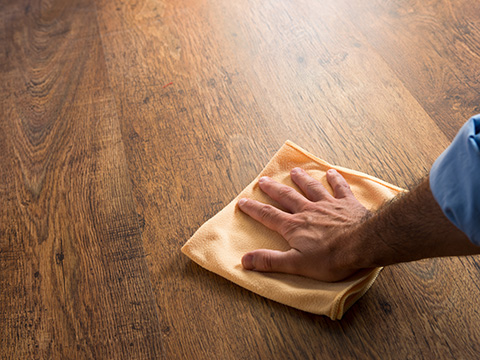
 Steam Mop2 days ago
Steam Mop2 days agoCan You Use a Steam Mop on Vinyl Plank Flooring?
-

 Steam Mop2 days ago
Steam Mop2 days agoCan I Use a Steam Mop on Laminate Floors?
-

 Cleaning2 hours ago
Cleaning2 hours agoExploring Uncommon Areas Where Latte Spills May Occur And How To Clean Them
-
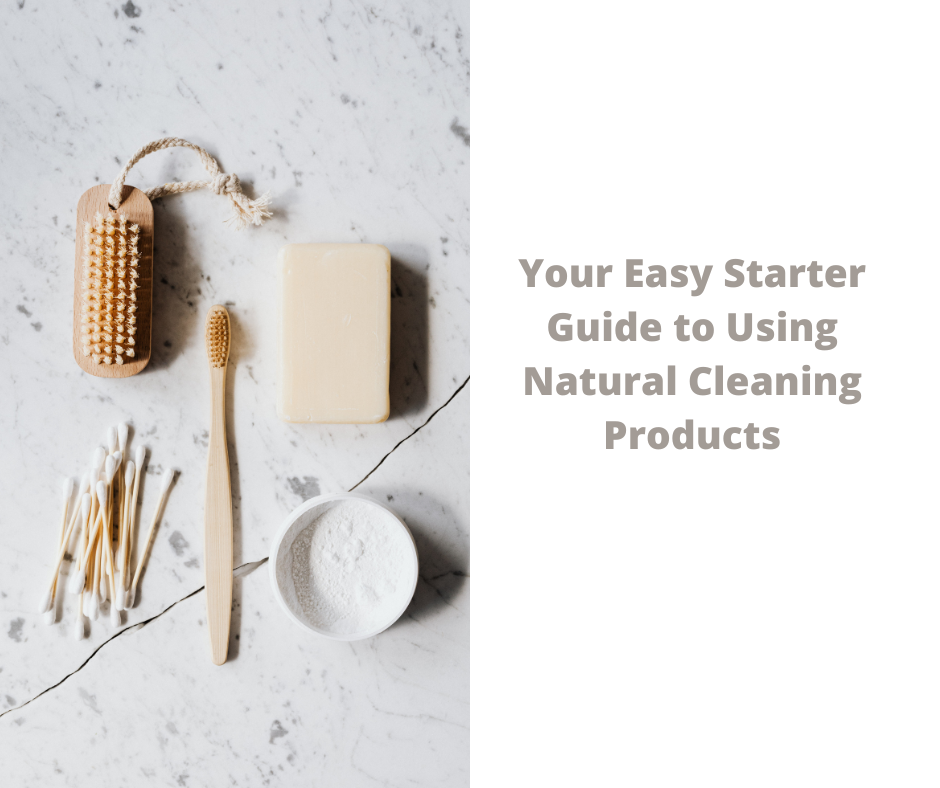
 Beginners Guides2 days ago
Beginners Guides2 days agoYour Easy Starter Guide to Using Natural Cleaning Products
